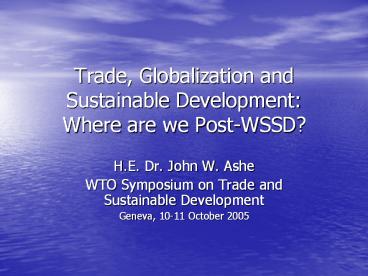Trade, Globalization and Sustainable Development: Where are we Post-WSSD? - PowerPoint PPT Presentation
Title:
Trade, Globalization and Sustainable Development: Where are we Post-WSSD?
Description:
What are the major multilateral processes shaping the interactions among trade, ... EU enlargement; regional trade agreements. Infrastructure development ... – PowerPoint PPT presentation
Number of Views:111
Avg rating:3.0/5.0
Title: Trade, Globalization and Sustainable Development: Where are we Post-WSSD?
1
Trade, Globalization and Sustainable
DevelopmentWhere are we Post-WSSD?
- H.E. Dr. John W. Ashe
- WTO Symposium on Trade and Sustainable
Development - Geneva, 10-11 October 2005
2
Outline
- Leading Question
- Overview of Major trends
- Changing nature of trade barriers
- NTBs
- Domestic regulations
- Trade and MEAs
- Trade in Environmental Goods Services
- Concluding Remarks
3
- What are the major multilateral processes
shaping the interactions among trade,
globalization and sustainable development? - WTO-Doha
- Monterrey Consensus
- 2005 World Summit
- CSD
- Multilateral environmental agreements
4
WSSD and Trade JPOI
- Call for timely conclusion of Doha Development
Round, specifically - Improved market access for developing countries
- Reduction with view to phasing out agriculture
export subsidies, trade-distorting domestic
support - Support for trade-related technical assistance
and capacity-building - Duty-, quota-free access to exports of LDCs
- Building capacity to diversify exports
5
Trade and Sustainable Development the JPOI links
- Incentives to adopt efficient, clean technology
- Increased availability, lower cost of clean
technology - Technology transfer through export-oriented FDI
- Information sharing with small- and medium
enterprises
6
Structure of world trade and the position of
developing countries
- Developing countries account for a growing share
of world trade, including for manufactures and
services
7
(No Transcript)
8
Non-traditional export opportunities for
developing countries
- Moving up value-chain does not always mean moving
from primary commodities to manufactures - natural-resource based industries
- services
9
Low-income countries still face obstacles to
world trade integration
- Tariff escalation remains a problem
- Other trading costs weigh heavily
- Weak supply side response
- Even as tariff rates fall, non-tariff barriers
remain and even increase
10
Source UN-ECLAC, Agricultural Development Unit,
based on WITS/TRAINS data (World Integrated
Solution, Trade Analysis Information System).
11
Non-tariff barriers (NTBs)
- Non-tariff barriers (NTBs) are an increasing
source of concern especially for the worlds
poorer nations - Currently affect up to 40 of the exports of the
world's least developed countries - Wide ranging (direct and indirect)
12
Evolution of NTB use by category
Source UNCTAD TRAINS database
13
The trend in the evolution of NTBs creates a
challenge for JPOI
- Thwarts the role of trade in achieving
sustainable development, by, inter alia - Affecting higher value aquaculture exports,
making moving up value chain more difficult - Risk of market fragmentation
- Measures often exceed multilaterally accepted
norms - Challenge for small economies and community-based
entrepreneurial capacity
14
Domestic environmental legislation and barriers
to trade
- National legislation and regulatory regimes can
act as barriers to trade-related sustainable
growth. - Examples
- Biofuels are environmentally preferable products
but effected by protective trade rules - Approval of biotech products is long and complex
in key markets - Foreign organic production systems are not
recognized key markets, requiring dual
certification.
15
Trade and Multilateral Environmental Agreements
- Proliferation of trade agreements and
environmental agreements - Agenda 21 of the Rio Conference states that
measures should be taken to avoid unilateral
action to deal with environmental challenges
outside the jurisdiction of the importing
country - WTO Members have agreed to clarify the legal
relationship between WTO rules and MEAs - No disputes have thus far come to the WTO
regarding the trade provisions contained in an
MEA - Of the approximately 200 MEAs currently in force,
only about 20 contain trade provisions.
16
Trade in Environmental goods and services
- Opportunity for fast tracking
- Trade in environmental Goods and Services is
sizable and growing fast - Elimination of tariff and non-tariff barriers to
environmental goods and services
17
Growth of environmental goods trade, 1990-2002
Source Bora and Teh (2004). Tariffs and Trade in
Environmental Goods. WORKSHOP ON ENVIRONMENTAL
GOODS, Geneva, 11 October 2004. WTO Secretariat.
18
Growth Factors for environmental goods and
services
- Domestic regulation and public pressure
- Customer requirements global supply chains
- EU enlargement regional trade agreements
- Infrastructure development
- MEAs and associated financing mechanisms
19
Measures to address market access concerns
- Enable developing countries to be more involved
in standard setting - Enhance the capacity of developing countries to
deal with NTBs - Formulate a balanced approach towards
disciplining arbitrary and abusive use of such
barriers
20
Measures to foster intl diffusion of
environmental goods and services
- Public financing, risk sharing for export of EGS
consistent with international trade
disciplines, e.g., - waste-water treatment technology
- flue gas capture
- methane capture from landfills for power
geneneration - waste incineration, including for power generation
21
Conclusion
- Firm groundwork in major multilateral processes
- Progress on implementation is vital
- Successful completion of Doha would mean greater
progress in sustainable development objectives - Reversal of the trend in escalating NTBs
- Addressing market-access concerns for developing
countries - More can be achieved by focusing on areas of
opportunity for fast-tracking - Trade in Environmental Goods and Services
- Cleaner production technology































